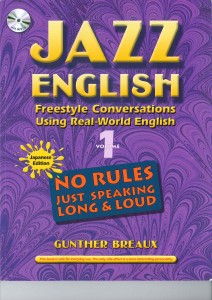EFL eikaiwa high school junior high school Language learning materials reviews speaking teaching textbooks university
by sendaiben
5 comments
Jazz English
Published by Compass, Jazz English is a speaking textbook for lower-intermediate students. It works very well with junior high school students that have been studying for a while and are ready to take things to the next level in terms of speaking, as well as with high school and I imagine lower level university students. I have only used the first textbook, so this review does not address Jazz English 2, nor the companion workbook (which I am going to try soon).
The textbook consists of ten main units and three supplementary ones, with all units following the same pattern: new vocabulary, conversation prompt questions, a dialogue, a short reading section, a crossword to practice the vocabulary, a short reading task, exercises to support speaking, and a final speaking activity.
The focus of the book is for students to develop more autonomy while speaking, and to try to have longer and more complex conversations. It does this very well, at least in my experience, with students that have a solid base of vocabulary and English exposure, and who are motivated to improve their conversational skills. Our ‘advanced’ classes, consisting of junior high and high school students that have been studying for four or more years took to it very well.
This has been a real find for us this year, and I wholeheartedly recommend it for classes similar to the one described above. The course requires a lot of student input, so this book would not work well with unmotivated or reluctant learners.
Anybody else using Jazz English?
curriculum EFL expectations language courses Language learning online resources teaching technology university
by sendaiben
5 comments
Independent study in a computer lab (my steep learning curve starts here!)
I started teaching in a computer lab for the first time this semester. It’s been a bit traumatic so far, as the classroom dynamic changes a lot, but I’m enjoying the challenge so far.
Yesterday we had our first proper class, and I decided to run it as an independent study session to allow students to familiarize themselves with some useful online tools. There were 35 2nd-year non-English majors in the class, and their English ability and familiarity with computers varied wildly. You can see my lesson briefing on my teaching blog here.
The lesson was partly successful, but I can see how to make it better and was very excited by the potential of using a blog or website to communicate with students. Here are my major impressions of the class:
- I tried to do far too much. None of the students had enough time to finish, and that was very harmful to the classroom atmosphere and their feelings towards the course. This is the #1 thing I would change about the lesson
- Only a couple of students asked questions/for help. Need to spend more time getting the class comfortable with calling me over to help with problems
- Unforeseen technical problems reared their ugly heads: the NY Times website does not allow popjisyo to load individual articles (something I only noticed when a student pointed it out) and the edublogs comment feature is a bit too aggressive in its attempts to deter spambots. Both of these caused a lot of frustration to my students
conference EFL eikaiwa language courses Language learning online resources presentations self-study technology TED theory
by sendaiben
2 comments
The future of online language learning and translation
This video is really interesting and a little scary. I’m going to have to start polishing my resume.
EFL eikaiwa ES extensive reading kids language courses Language learning materials Penguin Kids Readers readers Reading Review reviews school management teaching
by sendaiben
4 comments
Penguin Kids Readers
Resuming our kids’ readers roundup after a brief hiatus 🙂
I received a set of these a couple of weeks ago from the publisher (thanks!). While I appreciate the gesture, it will not affect how I review them here.
Having said that, this is a fantastic new series that has a lot going for it. There are currently 23 readers over six levels of difficulty.
Level 1 (200 headwords)
Level 2 (400 headwords)
Level 3 (600 headwords)
Level 4 (800 headwords)
Level 5 (1000 headwords)
Level 6 (1200 headwords)
As you can see, the jump between levels is fairly minimal, something that is extremely important for beginner and younger readers.
The current titles are all based on Disney films, and the artwork and covers are beautiful. The writing isn’t bad, either, in that the books actually tell coherent stories. That is often a problem with low-level readers based on films or TV content -they try to fit in too much with a minimal wordlist so the stories end up not making sense. Luckily that is not the case here. In many of the books they have taken just one scene from a film and told that. Our students found the books really attractive due to the topics, but there was enough of a spread that they had not seen all of the movies featured.
Another thing I liked were the simple exercises in the back of the books. They have pre-reading and post-reading questions that are visual and fairly easy -perfect to do in class after reading or to check out of class reading. If anything, I would have liked to see this section be slightly longer.
Apparently the series will end up having twelve books at each level, and there will be different content in the next wave of books (ie not just Disney).
Overall, this is a fantastic new resource. We ended up ordering two more sets, and I’m really looking forward to the release of the rest of the books in this series.
curriculum EFL evaluation expectations language courses Language learning teaching testing university
by sendaiben
leave a comment
New (Academic) Year’s Resolutions
Now that we are two three months into 2010 2012 (can you tell when I started writing this post?), it seems like a good time to think about new year resolutions. I didn’t make any specific ones this year, but I would like to make some for the next academic year.
In Japan the academic year runs from April to March, and at universities at least classes finish in February, allowing teachers some much-needed downtime to do admin, write papers, and think about next year’s classes.
So what am I going to focus on next year?
One of my priorities as a teacher and learner is effectiveness, or maximising results. I want to continue making my classes as effective as possible. I define effectiveness as the amount of learning over a certain time.
For my university classes, I am working off the following assumptions:
1. my students have already studied enough grammar
2. we only have a maximum of 22 hours together
3. my students actually want to learn English
4. most of my students don’t know how to get better at English
5. there are things I can teach my students that will help them improve their English
6. tests and quizzes, while very useful for assigning letter grades, are not very helpful
I am going to be teaching the following classes next year:
Reading
Communication
Listening
Presentation
I have already submitted my syllabi and know more or less what we are going to be doing, but I would be very interested to hear any advice or ideas about what I should do in each of these. I’ll be posting the contents later in the week. Please comment below.



